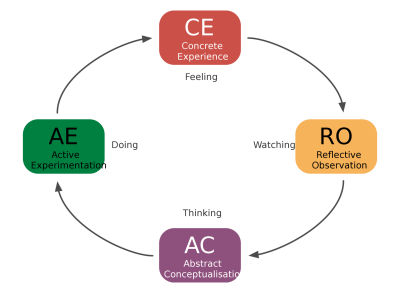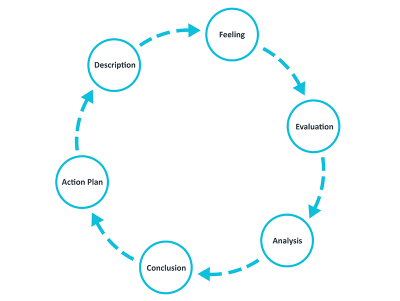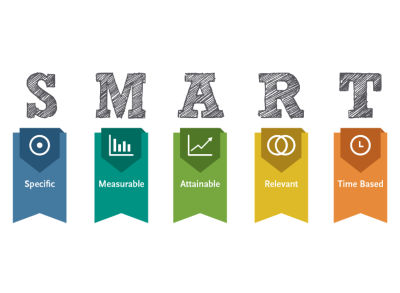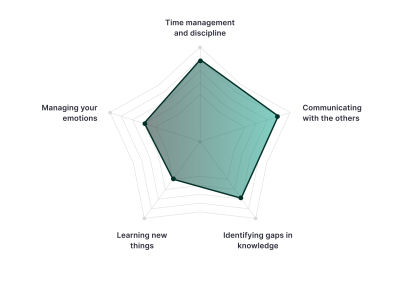Discover the importance of critical reflective practice and challenge some beliefs about reflection and its role in our work and growth. Kristian Mikhel suggests a critical reflective routine for individual contributors and gives some practical recommendations that will make reflection meaningful and actionable.
Have you ever looked back at your younger self and wondered, “What was I even thinking?” If you have, then you know how important it is to acknowledge change, appreciate growth, and learn from your mistakes.
Søren Kierkegaard, the first existentialist philosopher, famously wrote:
“Life can only be understood by looking backward, but it must be lived forwards.”
— Søren Kierkegaard
By looking back at our past selves, we compare them not only to who we are today but to who we want to be tomorrow.
This process is called reflection.
Critical reflection is the craft of “bringing unconscious aspects of experience to conscious awareness, thereby making them available for conscious choice.” At its core, reflection focuses on challenging your takeaways from practical experiences, nudging you to explore better ways of achieving your goals.
Learning and growth are impossible without reflection. In the 1970s, David Kolb, an educational theorist, developed the “Cycle of Learning”, comprising four stages: Concrete Experience, Reflective Observation, Abstract Conceptualization, and Active Experimentation.
According to Kolb, each new experience yields learning when all of its aspects are analyzed, assessed, and challenged — in theory (through reflection and conceptualization) and in practice (through experimentation). In turn, new learning informs new experiences, therefore completing the circle: act, analyze, challenge, plan, repeat.

Reflection takes the central stage: it evaluates the outcomes of each concrete experience, informs future decisions, and leads to new discoveries. What’s more important, reflection takes every aspect of learning into consideration: from actions and feelings to thoughts and observations.
Design is, by nature, reflective. Ambiguity requires designers to be flexible and analyze the situation on the go. We need to adapt to the ever-changing environment, learn from every failure, and constantly doubt our expertise. Rephrasing Donald Schön, an American philosopher, instead of applying experience to a situation, designers should be open to the “situation’s back talk.”
On the other hand, designers often reflect almost unconsciously, and their reflections may lack structure and depth, especially at first. Reflection is the process of “thinking analytically” about all elements of your practice, but structureless reflection is not critical nor meaningful.
Luckily, a reflective framework exists to provide the necessary guidance.
Practicing Critical Reflection #
In 1988, Professor Graham Gibbs published his book Learning by Doing, where he first introduced the Reflective Cycle — a framework represented by a closed loop of exercises, designed to help streamline the process of critical reflection.

In a nutshell, reflection comes down to describing the experience and your feelings towards it, analyzing your actions and thoughts, and devising an action plan. What sets it apart from a retrospective is continuity: the cycle is never complete, and every new iteration is built on the foundation of a previous one.
Imagine a situation: You are tasked with launching a survey and collecting at least 50 responses. However, a week later, you barely receive 15, despite having sent it to over a hundred people. You are angry and disappointed; your gut tells you the problem is in the research tool, and you are tempted to try again with another service.
Then, you take a deep breath and reflect on the experience.
Describe the situation #
Begin by describing the situation in detail. Remember that a good description resembles a story, where every event is a consequence of past actions. Employ the “But & Therefore” rule of screenwriting and focus on drawing the connection between your actions and their outcomes.
First, provide a brief outline: What did you do, and how did it go?
Last week, I launched a research survey using Microsoft Forms, but despite my best efforts, it failed to collect a number of responses large enough to draw a meaningful conclusion. Upon analyzing the results, I noticed that a significant portion of the participants bounced from the question, which required them to choose a sector of a multi-layered pie chart.
Then, add some details: describe how you went about reaching your objective and what was your assumption at the time.
The technical limitations of Microsoft Forms made embedding a large image impossible, so I uploaded a low-resolution thumbnail and provided an external link (“Click to enlarge the image”). A large portion of participants, however, did not notice the link and couldn’t complete the task, stating that the image in the form was too small to comprehend. As a result, we have only collected 15 complete responses.
Recommendations #
- Avoid analyzing the experience at this stage. Focus on describing the situation in as many details as possible.
- Disregard your experience and your gut urging you to solve a problem. Be patient, observant, and mindful.
- Reflection doesn’t have to take place after the experience. In fact, you can reflect during the event or beforehand, trying to set the right expectations and plan your actions accordingly.
Describe Your Feelings #
At this stage, focus on understanding your emotions before, during, and after the experience. Be mindful of the origin of your feelings and how they manifested and changed over time.
I was rather excited to see that Microsoft Forms offer a comprehensive set of survey tools. Moreover, I was captivated by the UI of the form, the option to choose a video background, and the feature that automatically calculated the time to complete the survey.
You will notice how describing your emotions helps you understand your motivations, beliefs, and convictions. In this particular example, by admitting to being enchanted by the platform’s interface, you essentially confirm that your decision was not a result of reasonable judgement or unbiased analysis.
I was somewhat disappointed to learn that I could not embed a large image, but I did not pay enough attention at the time.
This step is important: as your feelings change, so do your actions. A seemingly minor transition from “excitement” to “disappointment” is a signal that you have obviously overlooked. We will get back to it as we begin analyzing the situation.
Lastly, focus on your current state. How do you feel about your experience now when it’s over? Does any emotion stand out in particular?
I feel ashamed that I have overlooked such an obvious flaw and allowed it to impact the survey outcome.
Describing your emotions is, perhaps, the most challenging part of critical reflection. In traditional reflective practice, emotions are often excluded: we are commanded to focus on our actions, whether we are capable of acting rationally and disregard the feelings. However, in modern reflection, emotional reflection is highly encouraged.
Humans are obviously emotional beings. Our feelings determine our actions more than any facts ever could:
- We react positively to and support ideas that we like;
- It takes us a fraction of a second to make up our minds about anything;
- We are ready to defend an obviously flawed product if we like its appearance.
“
Recommendations #
- Analyze your feelings constantly: before, during, and after the action. This will help you make better decisions, challenge your initial response, and be mindful of what drives you.
- Don’t think you are capable of making rational decisions and don’t demand it of others, too. Emotions play an important role in decision–making, and you should strive to understand them, not obtain control over them.
- Don’t neglect your and your team’s feelings. When reflecting on or discussing your actions, talk about how they made you feel and why.
Evaluate And Analyze #
Evaluation and analysis is the most critical step of the reflective process. During this stage, you focus not only on the impact of your actions but on the root cause, challenging your beliefs, reservations, and decisions.
W3C’s guidelines for complex images require providing a long description as an alternative to displaying a complex image. Despite knowing that, I believed that providing a link to a larger image would be sufficient and that the participants would either be accessing my survey on the web or zooming in on their mobile devices.
Switching the focus from actions to the underlying motivation compliments the emotional reflection. It demonstrates the tangible impact of your feelings on your decisions: being positively overwhelmed has blinded you, and you didn’t spend enough time empathizing with your participant to predict their struggles.
Moreover, I chose an image that was quite complex and featured many layers of information. I thought providing various options would help my participants make a better-informed decision. Unfortunately, it may have contributed to causing choice overload and increasing the bounce rate.
Being critical of your beliefs is what sets reflection apart from the retelling. Things we believe in shape and define our actions — some of them stem from our experience, and others are imposed onto us by communities, groups, and leaders.
Irving Janis, an American research psychologist, in his 1972 study, introduced the term “groupthink”, an “unquestioned belief in the morality of the group and its choices.” The pressure to conform and accept the authority of the group, and the fear of rejection, make us fall victim to numerous biases and stereotypes.
Critical reflection frees us from believing the myths by doubting their validity and challenging their origins. For instance, your experience tells you that reducing the number of options reduces the choice overload as well. Critical reflection, however, nudges you to dig deeper and search for concrete evidence.
However, I am not convinced that the abundance of options led to overwhelming the participants. In fact, I managed to find some studies that point out how “more choices may instead facilitate choice and increase satisfaction.”
Recommendations #
- Learn to disregard your experience and not rely on authority when making important decisions. Plan and execute your own experiments, but be critical of the outcomes as well.
- Research alternative theories and methods that, however unfamiliar, may provide you with a better way of achieving your goals. Don’t hesitate to get into uncharted waters.
Draw A Conclusion And Set A Goal #
Summarize your reflection and highlight what you can improve. Do your best to identify various opportunities.
As a result, 85% of the participants dropped out, which severely damaged the credibility of my research. Reflecting on my emotions and actions, I conclude that providing the information in a clear and accessible format could have helped increase the response rate.
Alternatively, I could have used a different survey tool that would allow me to embed large images: however, that might require additional budget and doesn’t necessarily guarantee results.
Lastly, use your reflection to frame a SMART (Specific, Measurable, Achievable, Relevant, and Time-Bound) goal.

Only focus on goals that align with your professional and personal aspirations. Lock every goal in time and define clear and unambiguous success criteria. This will help you hold yourself accountable in the future.
As my next step, I will research alternative ways of presenting complex information that is accessible and tool-agnostic, as this will provide more flexibility, a better user experience to survey participants and ensure better survey outcomes for my future research projects. I will launch a new survey in 14 days and reflect accordingly.
At this point, you have reached the conclusion of this reflective cycle. You no longer blame the tool, nor do you feel disappointed or irate. In fact, you now have a concrete plan that will lead you to pick up a new, relevant, and valuable skill. More than that, the next time the thrill takes you, you will stop to think about whether you are making a rational decision.
Recommendations #
- SMART is a good framework, but not every goal has to fit it perfectly. Some goals may have questionable relevancy, and others may have a flexible timeline. Make sure you are confident that your goals are attainable, and constantly reflect on your progress.
- Challenge your goals and filter out those that don’t make practical sense. Are your goals overly ambiguous? How will you know when you have achieved your goal?
Daily Reflection #
Reflection guides you by helping you set clear, relevant goals and assess progress. As you learn and explore, make decisions, and overcome challenges, reflection becomes an integral part of your practice, channels your growth, and informs your plans.
Reflection spans multiple cognitive areas (“reflective domains”), from discipline and motivation to emotional management. You can analyze how you learn new things and communicate with your peers, how you control your emotions, and stay motivated. Reflecting on different aspects of your practice will help you achieve well–balanced growth.

As you collect your daily reflections, note down what they revolve around, for example, skills and knowledge, discipline, emotions, communication, meaningful growth, and learning. In time, you may notice how some domains will accumulate more entries than others, and this will signal you which areas to focus more on when moving forward.
Finally, one thing that can make a continuous, goal-driven reflective process even more effective is sharing.
Keeping a public reflective journal is a great practice. It holds you accountable, requires discipline to publish entries regularly, and demands quality reflection and impact analysis. It improves your writing and storytelling, helps you create more engaging content, and work with the audience.
Most importantly, a public reflective journal connects you with like-minded people. Sharing your growth and reflecting on your challenges is a great way to make new friends, inspire others, and find support.
Conclusion #
In Plato’s “Apology,” Socrates says, “I neither know nor think I know.” In a way, that passage embodies the spirit of a reflective mindset: admitting to knowing nothing and accepting that no belief can be objectively accurate is the first step to becoming a better practitioner.
Reflection is an argument between your former and future selves: a messy continuous exercise that is not designed to provide closure, but to ask more questions and leave many open for further discussions. It is a combination of occasional revelations, uncomfortable questions, and tough challenges.
Reflection is not stepping out of your comfort zone. It is demolishing it, tearing it apart, and rebuilding it with new, better materials.
Don’t stop reflecting.
No comments:
Post a Comment